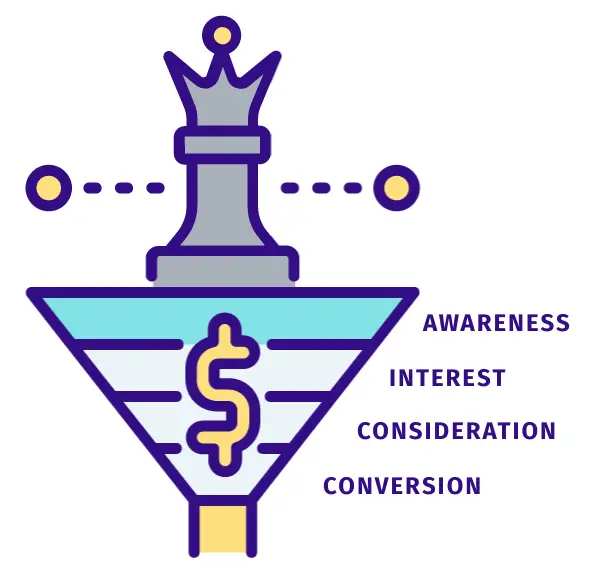Social media must integrate with lead generation efforts. For B2B digital marketers, that’s a foregone conclusion.
Social media’s fit with lead generation can be challenging to grasp at first. This is partly because communication processes in a traditional B2B lead nurture “funnel” are visualized as sequential – Awareness => Interest => Consideration => Sale.
Visualizing a funnel helps marketers tailor emails and other content to the steps prospects take as they move toward a purchase.
However, a prospect’s use of social media may not have a tidy, sequential pattern to it, which is one reason why visualizing the impact of social media on the funnel can be challenging. As I considered the impact of social channels on my lead generation programs, I realized I had to take into account the fact that my potential customers can engage with social media throughout their buying cycle. These engagements are often referred to as “touchpoints”, and the more your customer has with your brand, the higher the chance is that they will recognize it and will be more willing to engage.
In other words, social-media-driven engagements help at every stage of the funnel, contributing to a higher conversion rate through brand awareness.
More importantly, social media is more effective for lead generation purposes when used in conjunction with other sales tools, especially marketing automation, because it adds insights, reinforces relationship building, and builds brand recognizability.
Since my prospects’ needs evolve as they move from early-stage awareness through late-stage vendor validation, what social media can contribute to their process evolves also.
Unique Social Engagement Opportunities Show Up in Every Stage of Lead Nurture
Awareness: Inbound and Outbound Tactics
Social media impact on Phase 1: visibility and approachability. During this phase, marketers try to start relationships with prospects. Social media can:
- Improve prospects’ chances of seeing relevant web content in organic search. Search engines are placing more importance on “social signals” when determining the ranking of keyword-optimized content.
- Increase the chance that prospects will hear about a solution from people they trust. Social media helps marketers leverage a large network of “influencers” or thought leaders.
- Allow prospects to discover new solutions and ask for more information while hanging out in communities where they’re comfortable. Marketers can take their messages to prospects’ digital comfort zones and then give them the chance to opt in to email communication.
Marketing automation software simplifies the task of adding social touches to traditional marketing tactics, such as featuring YouTube videos or social sign-in options to landing pages. Some programs allow marketers to research key social influencers in their niche. Automation platforms also simplify the task of coordinating status updates, blogs, tweets, and email sends.
Interest
Social media impact on Phase 2: social sharing of content and insight into prospects’ needs. At this point, marketers are trying to increase the number of people being nurtured within a target account, provide a personal touch to those relationships, and accelerate their progress through the funnel. Social media can:
- Encourage prospects to share content with their friends and followers. Social channels provide effective alternatives to email or, better yet, extend the reach of email marketing. This is the foundation of an effective digital business card.
- Improve the sales experience for potential clients. Marketers can use social media to research prospects and tailor conversations specifically to their needs.
How marketing automation fits in: Some automation platforms have social sharing features embedded in emails, which improves viral marketing. Others enrich CRMs with social data, which improves marketing productivity.
Consideration
Social media impact: showcase consultative expertise and insight into prospects’ needs. As Sales engages with mature leads, they need to maintain the trust that has been built through Phases 1 and 2. At this point, social media can:
- Provide prospects with proof of the salesperson’s expertise. Sales representatives can use their personal social profiles to engage their industry through LinkedIn, Twitter, and other networks.
- Improve the sales experience for potential clients, similar to Phase 2.
How marketing automation fits in: Automation software allows emails to be customized with the sales manager’s name, reinforcing the personal relationship they have developed with the prospect. As mentioned above, some automation platforms enrich prospect profiles with social data. Marketing automation tools can also be programmed to revisit qualified prospects who fall out of the funnel at this stage.
Conversion
The last phase in the funnel opens a new door for social media engagement with customers post-sale, also supported by CRM and marketing automation features.
Social media can have a significant impact at every stage of the B2B sales funnel, from raising awareness to closing deals and maintaining customer relationships. By integrating social media touchpoints into their marketing automation platforms, B2B marketers can increase brand visibility, encourage content sharing, showcase their expertise, gain customer insights, and provide a more personalized buyer experience.
Image: Envato Elements
The post originally appeared on following source : Source link

